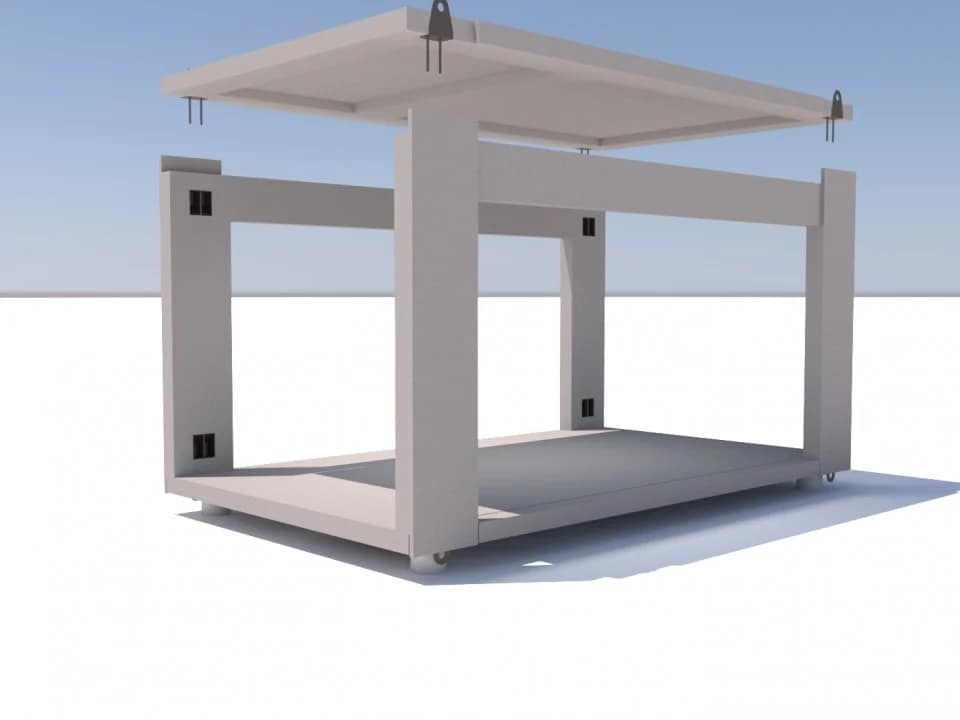
Precast concrete construction is becoming one of the most efficient and predictable ways to build modern structures, giving project teams more control over quality, schedule, and on-site safety.
You want clear answers, fewer surprises on site, and a faster path from design to ribbon cut. This guide explains how precast concrete works, where it shines, and what to watch. We reference standards and industry manuals throughout so you can check each claim.
Here is why this matters. Precast concrete arrives as finished pieces from a plant with documented curing and testing. Work happens off site while foundations and utilities move ahead. That sequence cuts weather risk and helps keep crews moving.
What is precast concrete in simple words
Precast concrete is concrete made off site in a controlled environment, then delivered to the construction site for installation. Plants place rebar or strands, cast, cure, and test before shipping. The goal is consistent strength, geometry, and finish.
This reliability is one of the biggest advantages of precast concrete construction compared to traditional on-site methods.
What you need to know before you choose it
Decide spans and loads, fire and acoustic targets, insulation needs, connection types, and access for trucks and cranes. These choices drive panel thickness, strand layouts, and hardware. ACI 318 sets design requirements for structural members, including precast and prestressed concrete.
Precast concrete construction vs traditional poured concrete

Traditional poured concrete happens outdoors with on-site formwork and curing. Precast concrete construction moves those steps into a plant with steady curing conditions and repeatable formwork, then sets pieces by crane on the job site. This approach supports shorter construction time and fewer weather holds.
Because precast concrete construction shifts production into a controlled plant environment, builders reduce weather delays and achieve more consistent performance.
The advantages of precast concrete
- Work in parallel. Plants fabricate off site while site crews handle earthwork and utilities. Here is why that helps: you remove weather from the critical path and start interiors sooner once panels land.
- Documented quality control. These QC benefits are a core reason why precast concrete construction is increasingly chosen for complex commercial and institutional projects. NPCA’s Quality Control Manual defines plant procedures for batching, curing, and testing that support consistent material quality.
- Safer winter work. Plant casting continues during cold or wet seasons using covered beds and controlled temperature curing.
Typical precast concrete elements and precast products
You will see wall panels, slabs, double tees, beams, columns, stairs, and barriers. Double tees carry long spans in parking structures and large floor plates. Sandwich wall panels combine structure, insulation, and finish. Omega Precast supplies these precast concrete products to suit local haul limits and crane plans.
Inside the plant: controlled environment and controlled process
Crews prepare forms, place rebar or prestressing strand, set embeds, cast, then cure to reach specified strength. The plant records temperatures, mix IDs, and test breaks. PCI and NPCA manuals govern quality control steps for architectural precast and structural members. This level of documentation and traceability is difficult to achieve with cast-in-place work, giving precast concrete construction a clear advantage in projects with tight specifications.
Mixes, materials, and durability
Designers specify a concrete mix by strength and exposure. ASTM C150 lists cement types used in concrete, including air-entraining options for freeze-thaw durability. Plants often add supplementary cementitious materials and use recycled materials where local specs allow. ACI 318 addresses cover, exposure classes, and detailing that help prevent corrosion for extended periods.
Prestressed concrete or reinforced concrete
Prestressed concrete uses tensioned strands to reduce cracking and increase span. It fits floor members such as double tees and certain wall panels. Reinforced concrete uses rebar without prestress and suits foundations, walls, and many slabs. ACI 318 covers both methods. Let’s break it down with your spans and loads.
How insulated sandwich wall panels work
A sandwich panel has two concrete wythes separated by rigid insulation and tied with connectors. Panels can be composite, partial composite, or non-composite depending on connector stiffness. This assembly improves thermal performance while delivering structure and finish.
Connections, tolerances, and fit-up
Good drawings call out bearing pads, plates, welds, shim stacks, and grout keys. Erectors rely on agreed tolerances for members and joints to keep cranetime tight. PCI’s tolerance manuals describe recommended fabrication and erection tolerances for precast members. Accurate tolerances are essential to successful precast concrete construction, ensuring rapid crane time and minimal on-site adjustments.
Retaining walls and site structures
Precast concrete retaining walls install quickly and handle difficult layouts near property lines or traffic. Options include cantilever systems and modular block systems that stack large wet-cast units. NPCA guidance and best-practice manuals cover details, drainage, and installation methods.
Where precast fits best
- Parking structures. Long spans with double tees reduce columns and speed deck cycles.
- Office buildings and schools. Insulated wall panels enclose the frame quickly so interior walls and systems can start sooner.
- A commercial building with tight logistics. Off site fabrication cuts laydown and reduces heavy work at curb lanes, which keeps city neighbors happier.
Carbon, cement choices, and material needed
Cement drives most carbon emissions in concrete. One simple lever is portland-limestone cement, which can reduce mix footprint when it replaces ordinary portland cement in suitable work. Plants also look at mix design, energy, and haul planning to lower totals without hurting strength.
Cost and schedule notes you can use
Precast concrete construction moves production off site and supports a shorter construction time once the site is ready. That sequence may reduce labor costs tied to forming, reshoring, and weather holds. It also limits rework linked to rain or freeze events. For many contractors, these schedule savings make precast concrete construction a strong choice when working in climates with short building seasons. Want hard numbers. We baseline your drawings and provide a lift plan with truck counts so you can compare apples to apples.
Quality, testing, and documentation
Plants test cylinders or cores, log curing conditions, and track batch weights. The plant QC program aligns with PCI or NPCA manuals. Field crews verify piece marks, check bearing elevations, and grout schedule. You get submittals that list materials, embedded hardware, and connection types.
What is the downside of precast concrete
Large pieces need cranes and clear routes. Late design changes cost more once casting starts. Site access and powerlines can restrict swing. Here is how we handle it. We lock piece geometry early, model the erection sequence, and plan truck routes and crane pads with your team. PCI and ACI references help keep moves safe and repeatable.
Frequently asked questions
What are precast concrete steps
Precast steps arrive as finished units sized to your drawings. They connect with dowels or plates to foundations or landings and you can use them soon after installation.
How much do precast concrete panels cost
Panel cost depends on size, finish, insulation level, hardware, distance, and cranes. Share length, height, thickness, and finish target. We price a few options so you can balance first cost and schedule.
Is precast stronger than cast-in-place
Strength depends on design and curing. Plants cure in a controlled environment and verify compressive strength before shipping. ACI 318 sets the design framework for both precast and cast-in-place.
What is the difference between cast-in-place concrete and precast concrete
Cast-in-place forms and cures at the job site. Precast forms and cures off site, then installs by crane. Plants document the curing process, which supports repeatable results.
Is precast concrete cheaper than cast-in-place
On some projects yes, on others no. The full picture includes crane time, formwork, weather exposure, and start of interior trades. We create a piece schedule and compare.
What is the ACI standard for precast concrete
Use ACI 318 for design and ACI 301 for construction specifications and curing process. Your project spec cites both.
How to calculate precast concrete
For walls: length times height times thickness for volume, then add connections and embeds. For slabs and double tees: area times thickness, then check strand pattern, camber, and deflection with design tables. We run these numbers for you and show assumptions.
Putting it together on your project
Design requirements. Share loads, spans, fire ratings, acoustic needs, insulation R-values, and façade targets. We translate that into wall panels, slabs, and columns. We also confirm design codes, tolerances, and connection details with your engineer of record.
Foundations and interfaces. Show anchor locations, bearing elevations, grout keys, and slab edges. We coordinate inserts for interior walls, roof lines, and window rough openings.
Manufacturing and logistics. Pieces cast off site at our manufacturing plant move by truck in the needed sequence. We schedule around city curfews and coordinate escorts when required. We also plan laydown so other materials can keep flowing at the construction site.
Installation. Crews set, shim, and grout to the approved details. The erector records welds and torque values, then removes braces once strengths are met. Let’s break it down on a lift plan before steel shows up.
Where precast concrete panels and other materials meet
Interfaces matter. Coordinate sealants at panel joints, window frames, and roof edges. Work with your roofer and glazier on sequencing to avoid rework. PCI details offer clear methods for joints and interfaces.
Retaining walls in more detail
Precast concrete retaining walls can use cantilever stems or modular block systems with select backfill. DOT and FHWA publications show drainage and grading details that keep walls working for decades. Share surcharge, soil data, and site access early.
Safety and corrosion notes
Detail cover, water management, and sealers where deicing occurs. ACI 318 includes exposure classes and cover rules that help protect steel and prevent corrosion. Train riggers, control zones, and checklines before each pick.
When precast is the right fit
Pick precast when you need early enclosure, long spans, repeatable finishes, and documented quality control. It suits parking structures, office buildings, and many public projects. It also supports low-waste production with measured material needed and clear tracking of recycled materials. Precast concrete offers a strong path to a durable shell using a sustainable material. When timeline, consistency, and predictable results matter, precast concrete construction provides one of the most efficient paths to a durable, high-performance building envelope.
Related article
Precast Concrete 101: A Plain-English Guide From Omega Precast
ByJohn Ha
September 23, 2025
Blog
Precast Concrete 101: A Plain-English Guide From Omega Precast You want clear answers, fewer…
Read More
Your Project is Waiting
We’re Ready to Deliver!
Tell us about the project you’ve been planning, your desired timeline, and any challenges you’re facing. With our expert team will recommend the perfect concrete solution that optimizes both cost and quality while exceeding your expectations.
Free consultation, detailed quotes, and all just one click away.


